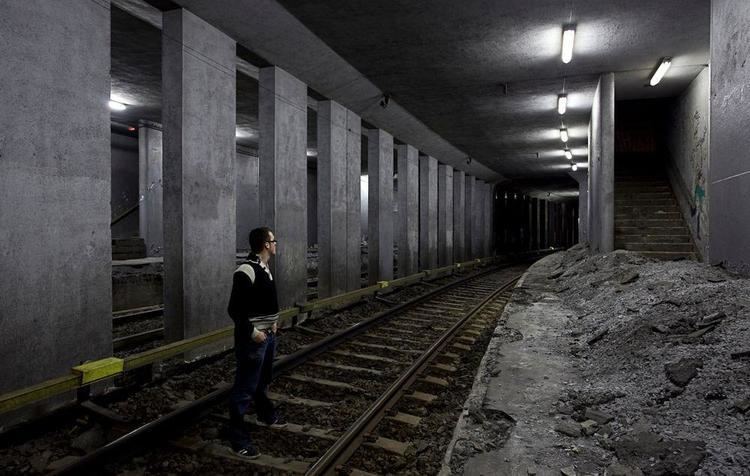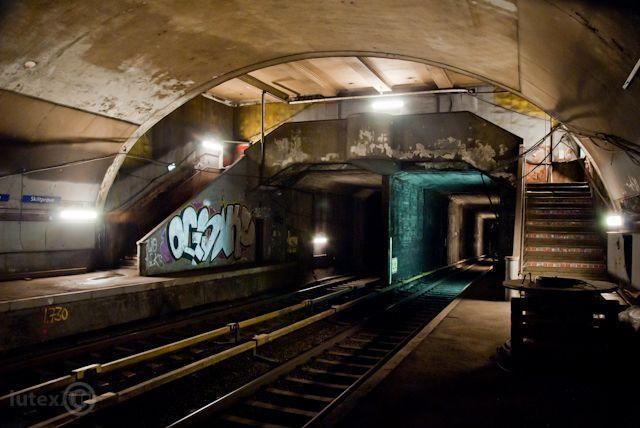 | ||
Down street underground ghost station
Ghost stations is the usual English translation for the German word Geisterbahnhöfe. This term was used to describe certain stations on Berlin's U-Bahn and S-Bahn metro networks that were closed during the period of Berlin's division during the Cold War. Since then, the term has come to be used to describe any disused underground station actively passed through by passenger trains, especially those on an underground railway line.
Contents
- Down street underground ghost station
- Ghost stations in london former underground stations
- Background
- Particular stations
- Reopening
- List of all Berlin ghost stations
- Ghost stations arisen after reunification
- Argentina
- Australia
- Austria
- Brazil
- Bulgaria
- Canada
- Czech Republic
- China
- Denmark
- France
- Germany
- Hong Kong
- Malaysia
- New Zealand
- North Korea
- Norway
- Lisbon Metro
- Moscow Metro
- Saint Petersburg Metro
- South Korea
- Spain
- Sweden
- Ukraine
- United Kingdom
- United States
- References

Ghost stations in london former underground stations
Background
In August 1961 the East German government built the Berlin Wall, ending freedom of movement between East and West Berlin. As a result, the Berlin public transit network, which had formerly spanned both halves of the city, was also divided into two. Some U- and S-Bahn lines fell entirely into one half of the city or the other; other lines were divided between the two jurisdictions, with trains running only to the border and then turning back. However, there were three lines—the U-Bahn lines now designated U6 and U8, and the Nord-Süd Tunnel on the S-Bahn—that ran for the most part through West Berlin but passed through a relatively short stretch of East Berlin territory in the city centre. These lines continued to be open to West Berliners; however, trains did not stop at most of the stations located within East Berlin, though for technical reasons they did have to slow down significantly while passing through. (Trains did stop at Friedrichstraße, on which more below.) The name Geisterbahnhof was soon aptly applied to these dimly lit, heavily guarded stations by travelers from West Berlin, who watched them pass by through the carriage windows. However, the term was never official; West Berlin subway maps of the period simply labelled these stations "Bahnhöfe, auf denen die Züge nicht halten" ("stations at which the trains do not stop"). East Berlin subway maps neither depicted the West Berlin lines nor the ghost stations. U-Bahn maps in the Friedrichstraße transfer station were unique: They depicted all the Western lines, but not the Geisterbahnhöfe, and showed the city divided into "Berlin, Hauptstadt der DDR" ("Berlin, capital of the German Democratic Republic") and "Westberlin."

The situation was obviously less than ideal. The lines were a vital part of the West Berlin transit network, but because part of the route of some of the lines lay in East Berlin territory, it was difficult for Western support staff to perform maintenance work on the tracks and tunnels. If a train on a West Berlin line broke down in East Berlin territory, then passengers had to wait for Eastern border police to appear and escort them out. The East German government occasionally hinted that it might someday block access to the tunnels at the border and run its own service on the East Berlin sections of these lines. However, this awkward status quo persisted for the entire 28-year period of the division of Berlin.

At the closed stations, barbed wire fences were installed to prevent any would-be escapees from East Berlin from accessing the track bed, and the electrically live third rail served as an additional and potentially lethal deterrent. An alarm was triggered if anyone breached one of the barriers. As for the entrances, the signage was removed, walkways were walled up and stairways were sealed with concrete slabs. Police stations were built into the windowed platform service booths, from which the whole platform area could be monitored.

A wide white line on the wall marked the exact location of the border. Later, gates were installed at some stations that could be rolled into place at night while the guards were off-duty. Guard posts at other stations were staffed continuously, creating additional employment positions with the transport police. In the platform area, the guards always worked in pairs, and care was taken in their assignment to assure that there would be no personal ties between them. In addition, superior officers could conduct surprise inspections at any time, thus, maintaining maximum security. Other stations were secured by the border guards.
Particular stations
Friedrichstraße station, though served by Western lines and located in East Berlin territory, was not a Geisterbahnhof. Instead, it served as a transfer point between U6 and several S-Bahn lines. Western passengers could walk from one platform to another without ever leaving the station or having to show papers, much like air travellers changing planes at an international airport. Westerners with appropriate visas could also enter East Berlin there.
The Bornholmer Straße S-Bahn station was the only ghost station not located in a tunnel. It was situated close to the wall near the Bornholmer Straße border crossing. West Berlin trains passed through it without stopping. East Berlin S-Bahn trains passed the same station but on different tracks. The tracks used by Western and Eastern trains were sealed off from each other by a tall fence.
Another oddity was Wollankstraße station. Like Bornholmer Straße, it was an S-Bahn stop served by West Berlin trains, but located on East Berlin territory just behind the border. However, Wollankstraße was in use and accessible for West Berliners, as one of its exits opened on a West Berlin street. This exit was exactly on the border line, a warning sign next to it informing passengers about the situation. Its other exits to East Berlin streets were blocked.
Reopening
The first people to enter the ghost stations after the fall of the Berlin Wall in November 1989 found that they lived up to their informal name, with ads and signage on the walls unchanged since 1961. None of them have been preserved.
The first ghost station to reopen to passenger traffic was Jannowitzbrücke (U8) on 11 November 1989, two days after the fall of the Wall. It was equipped with a checkpoint within the station akin to Friedrichstraße, where East German customs and border control were provisionally installed to facilitate passengers heading to or coming from East Berlin. Hand-drawn destination signs were hung up covering the old ones from pre-1961; these signs were both crumbling from age and obviously missing the termini of post-1961 line extensions. On 22 December 1989, Rosenthaler Platz (U8) was reopened with a similar provisional checkpoint.
On 12 April 1990, the third station to reopen was Bernauer Straße (U8). As its northern exit was directly on the border, it could be opened with direct access to West Berlin without the need of a checkpoint. Its southern exit towards East Berlin was not reopened until 1 July 1990.
Discussions on reopening all the U6 and U8 stations including the S-Bahn station Oranienburger Straße, Unter den Linden and Nordbahnhof had begun on 13 April 1990 without border controls. These took two months to clean up, removing all the dirt and refurbishing the interiors; all stations had been reopened on 1 July 1990 at 11 a.m., as East Berlin and East Germany had adopted the West German currency (DM), leaving the border checkpoints abandoned.
On 2 July 1990, Oranienburger Straße was the first ghost station on the Nord-Süd-S-Bahn to reopen. On 1 September 1990, Unter den Linden and Nordbahnhof were opened following reconstruction works. On 12 December 1990, Bornholmer Straße was reopened for West Berlin trains; a second platform for East Berlin trains allowing interchange followed on 5 August 1991. The very last ghost station to reopen was Potsdamer Platz, which opened on 3 March 1992, following an extensive restoration of the entire North-South tunnel.
In the following years, the city and German government put a great deal of effort into restoring and reunifying the S-Bahn and U-Bahn networks in Berlin. The U-Bahn system reached its pre-wall status in 1995 with the reopening of Warschauer Straße on U1. The S-Bahn system reached a preliminary completion in 2002 (with the reopening of the ring), even though there are still disused sections of lines closed in the aftermath of the wall. Decisions on reopening of some of these sections are still to be made.
List of all Berlin ghost stations
This list only includes those stations in East Berlin territory that western trains passed through without stopping. There were other stations on both sides of the wall that were closed during the division because those sections of track were not in use.
Temporary checkpoints were set up for stations with access to East Berlin that were reopened before 1 July 1990. Checkpoints were no longer necessary for those reopened after that date when border checks were eliminated with the currency union between East and West Germany.
Ghost stations arisen after reunification
In contrast with the above-listed stations, multiple stations in the Berlin area that were of high importance during the Cold War rapidly lost importance and passengers after reunification, some to the point of becoming ghost stations. The most notable examples are:
Argentina
The Buenos Aires Underground has four ghost stations. The two stations on Line A were originally two single-platform stations closed in 1953 since their close proximity meant trains had to stop in quick succession and frequencies were reduced. Their opposing platforms, located just metres away from each of the ghost stations, still remain open as Pasco and Alberti stations. The stations are preserved to maintain their original appearance and can still be seen when travelling on the line, even being used as a display for a time.
On Line E, the two stations were closed in 1966 when the line was re-routed closer to the centre of Buenos Aires in order to improve passenger numbers. They have both been used as maintenance areas for Line E and Line C, while one of the stations served as a set for the 1996 Argentine film Moebius. The stations were under consideration to be re-purposed as part of the new Line F, however it was later decided to build new tunnels instead.
There are also two stations (Apeadero Boedo and Apeadero Carranza) on Line E and Line D which were designed to be used as temporary stations while their respective lines were being extended. Though the platforms remain, they cannot be considered true ghost stations since they were never intended to be a permanent part of the network and designed to be re-purposed as electrical substations once the permanent stations were built.
Australia
Austria
Brazil
Bulgaria
Canada
Czech Republic
China
Denmark
France
Germany
Apart from Berlin:
Hong Kong
Malaysia
New Zealand
North Korea
Norway
All three are real ghost stations, underground stations with trains passing through.
